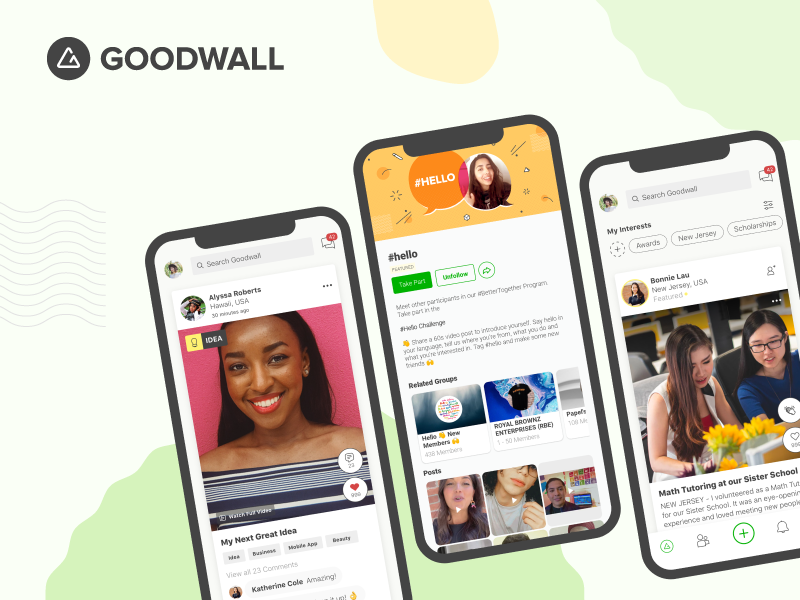“So tell us about yourself.”
That question may send a chill down your spine.
Where do you even start? Do you talk only about your work experience? Your personal life? Or just freeze up and say nothing?
Thankfully, resumes are usually the first glance that the employer will ever catch of you.
Wondering how to start a resume?
Whether you apply online, drop it off in person, or post it on every streetlight (which we don’t suggest), you have the opportunity to craft a polished written statement that answers that dreaded question.
That statement is what we call the resume introduction statement. Want to learn how to craft your own? Keep reading below!

Looking to Land Your Dream Job?
Sign up to Goodwall!
- Learn skills to become more competitive
- Create a professional portfolio to highlight accomplishments
- Search through over 5 million jobs & internships
- Ask career questions and receive support
Download the app now to get started for FREE!
Now, let’s get started with resume intros and opening statements:
First Impressions Are Huge
While first impressions aren’t everything, they are incredibly important. Especially when you are one lone resume in a sea of applicants. You need to shine!
Many scientific studies mention the importance of the first impression. According to one study, a person forms their first impressions about someone within the first 1/10th of a second of seeing them.
While you don’t need to worry about landing your dream job in 1/10th of a second, you need to think about how your first impression with the employer will occur.
If you submit your resume through any online platform, such as a job listing or an email, then the recruiter’s first impression of you will be when they open the document. If science backs up the claim that we make snap judgments within seconds, then we can assume that your resume introduction paragraph will be the true first impression.
So let’s make it awesome!
Related Read: How to List Education on a Resume: Complete Guide and Examples
What Is the Intention of an Opening Statement for Resume?
To make an awesome opening statement for your resume, we first need to break down what the purpose of the introduction really is. A Resume Introduction Paragraph is a short and clear way of sharing your personal interests and experiences with the employer. It is also a great way of clarifying what qualities you are looking for in a job.
Think about it like a first date for you and the company! (Actually, maybe don’t do that… that’s an HR nightmare waiting to happen.) Let’s use a different example.
A better example is the “Skip Ads” example: you are on YouTube, waiting to watch a new video. An advertisement comes up with a “You May Skip this Ad in 5 Seconds” button on the side.
What can that company say within the first 5 seconds that will get you to watch their advertisement?
Think about your resume’s opening statement as your personal advertisement. You are giving your potential employer a quick snippet of your product (which is you), and hopefully getting them to buy it!
Now that you understand the intention behind the resume introduction, let’s get into specifics. In the next section, we’ll break down the two main types of introduction paragraphs.
The Two Types of Introduction Paragraphs
There are two main types of resume intro paragraphs: The Resume Summary Statement and the Resume Objective Statement. While both set out to accomplish the same result, they are specifically formatted based on the amount of experience you have in the field.
The Resume Summary Statement is best for applicants with several years of experience in their field and are planning to progress within that field.
The Resume Objective Statement is best for those new to the industry or anyone making a career change/coming back from an employment gap.
We’ll go into depth on both of these options in the next two sections.
Related Read: Resume Job History: How to List Work Experience on a Resume Right
The Resume Summary Statement
A Resume Summary Statement is a quick way to organize and focus on many years of work experience and projects in a relevant subject area. Summary statements often include quantifiable stats about your work. Some examples of those include:
- Managed a remote team of over 50 people
- Contributed to boosting positive customer reviews by over 45%
- Prepared 300+ students for standardized testing
Remember: you are more than a number, and so is your work. Don’t exclude something you’re proud of just because it doesn’t look “impressive” enough.
Also remember: numbers alone can’t get you the job. If you can sandwich together your quantifiable stats with specific descriptors of the experiences you can’t put into numbers, you are golden!
Here’s an example of that:
“Seasoned and innovative event planner with over 6 years of experience in the Atlanta entertainment industry. Organized and executed events with an attendance of 500+ people. Maintains a strong relationship with local leaders and community members.”
This summary statement gives the reader both quantifiable and contextual job experiences, which humanizes the applicant and gives the reader a clearer picture of who you really are (and how skilled you are at writing!).
Don’t have any specific examples that fit the job you’re looking for? That’s ok! You might do better with an Objective Statement. Let’s discuss that next.
Related Read: Hobbies and Interests on a Resume: Why and How to Include Them
The Resume Objective Statement
Whether you’re entering the job market for the first time, coming back from a break, or switching career paths, you might feel as though you don’t have relevant enough experiences to list in a Resume Summary Statement.
That’s where objective statements come in!
Objective statements are better for highlighting skills rather than experience. This is a great way to showcase skills you’ve learned in school or from jobs in other industries.
Some examples of this include:
- Dedicated and motivated engineering graduate seeking entry-level assistant quality control manager position with Company X
- Looking to transition my 4 years of experience in client-facing problem solving into a more behind-the-scenes role
When writing an objective statement, the most important thing is to be specific. If you don’t have any quantifiable statistics about your job experience, you must be specific about where your current expertise fits in with the company.
Let’s use the “skip ads” example again here: you may have a product that people don’t think they need, but if you can garner even a smidge of that person’s interest within the first 5 seconds of your ad, they might try and find ways to justify purchasing your product.
Have you decided which type of statement is best for your experience level? Great! Now, let’s dive into how to start writing your personal statement.
Related Read: Resume Skills: How to Put Skills on a Resume the Right Way in 2021
How to Start
If you happen to already have an elevator pitch, that is a great place to start!
Don’t have an elevator pitch? Don’t worry. You can check out our other blog post on “How to Create an Elevator Pitch in 5 Easy Steps”.
If that rent payment is quickly approaching and you don’t have time to read another article, that’s ok too. Just follow these EASY instructions:
Examine
Examine your work history. What have you previously done that could fit this position? Is there a quantifiable way to state that? If so, do it!
Accomplishments
What are some of your most impressive accomplishments? These can be both in your work life and your personal life if it makes sense to include. (Maybe don’t tell them about that hot dog eating contest you won in Florida, though.)
Skills
Proficient in a certain software? Include that. Great at public speaking? Include that. If something you’re good at happens to fit a task you might face at this new job, include it!
Whatever you decide to include, make sure you can actually do it. And make sure you can do it on the spot if asked to.
You
You are more than your job experience. Recruiters aren’t hiring resumes, they’re hiring people. Make sure your opening statement matches the vibe that you want to give off.
For example, if you are an incredibly creative and outgoing person, you probably want to tell them more about your people skills than your Excel spreadsheet skills. No harm in mentioning both, just start with what you feel represents you best.
Related Read: How to List Your Achievements on Your Resume (the Right Way) in 2021
You Have Everything You Need to Succeed
Now that you have all of the information needed on how to open a resume, it’s time to do just that!
If you get stuck at any point or just need an extra boost of motivation before you start, remember this: you are enough.
You are not just your job experience, you’re a human being! Career changes, gaps in employment, and first jobs are all a part of life. You are exactly where you need to be to get the job you want.
Need help with the rest of your resume? We’ve got you!
Check out one of our other resume writing blog posts in our career section. And, if you have any questions on writing a great introduction statement or opening paragraph on a resume, just leave a comment below.
Thanks for reading, and good luck on your job hunt!
Related Read: 55 Resume Tips, Hacks & Expert Advice to Help You Score a Job Interview



